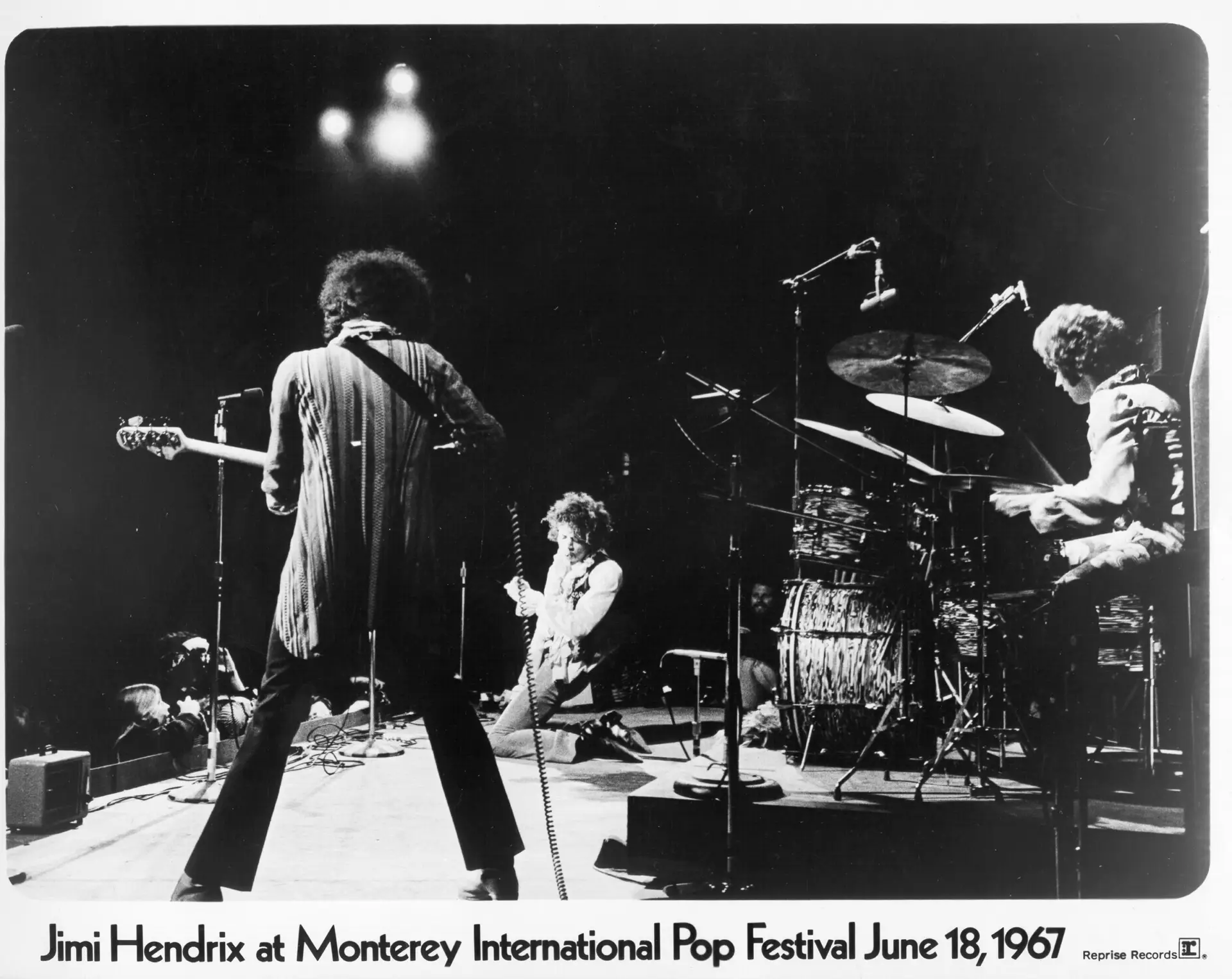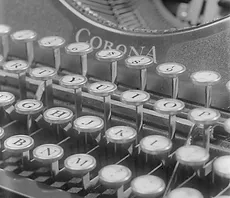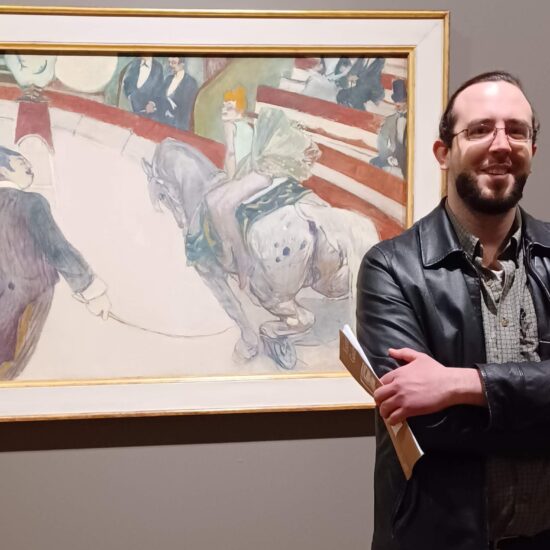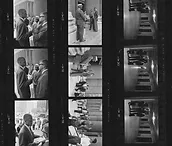Photo by Michael Ochs Archives/Getty Images
Conjecture rarely comes closer to a settled matter of fact than it does to say Jimi Hendrix was the greatest rock guitarist to ever live. He introduced himself to some of the hippest heads in America on the 18th of June 1967 in a glorious blaze at the Monterey International Pop Festival in California. The nine-song set he played that evening was an intense burst of brilliance that culminated in an act of bewildering destruction.
A cardinal event in what became the fabled “Summer of Love,” Monterey Pop drew tens of thousands from near and far to a fairground south of the countercultural mecca in San Francisco. Subject to major media attention and closely watched by record executives, the festival featured an extraordinary lineup of the already and about-to-be famous including Janis Joplin, Otis Redding, and The Who.
None, however, left such a lasting impression that weekend as did Hendrix.

Photo by Michael Ochs Archives/Getty Images
He came to that stage all the way from Swingin’ London. James Marshall Hendrix, born in 1942 and raised in Seattle, Washington, had languished in the United States as a sideman for the likes of Little Richard and the Isley Brothers.
He left in 1966 for London, where the Jimi of legend came alive by talking his way into joining a set with Cream, upstaging reigning guitar “God” Eric Clapton within days of landing. Pete Townshend, Mick Jagger, and Jeff Beck numbered among those left stunned in the weeks that followed.
At Monterey, he was accompanied by Noel Redding on bass and Mitch Mitchell on drums, a rocking power trio known straightforwardly as the Jimi Hendrix Experience. Spare in number, but not in sound, the name was uncommonly apt. While they had already cut three UK Top 40 hits, the little bit of their music that circulated in the states to that time had failed to gain traction.
Their Monterey appearance, therefore, came as a tremendous shock.
More than half of the Experience’s Monterey setlist were covers–of classic blues, of contemporary pop hits, and of Bob Dylan’s pathbreaking folk-rock track “Like a Rolling Stone.” Hendrix made each his own, demonstrating the overwhelming guitar sound, and the kind of wild onstage antics that had made him a sensation in London the previous autumn.
The performance started when Hendrix, wearing a bright feather boa, launched into an amped-up rendition of Chicago blues icon Charles “Howlin’ Wolf” Burnett’s song “Killing Floor.” He played the next number in part while hopping about with his instrument slung under one leg.
Not long after came the enormously memorable moment in which he raised the guitar to his face and began to briefly play a solo with his teeth.
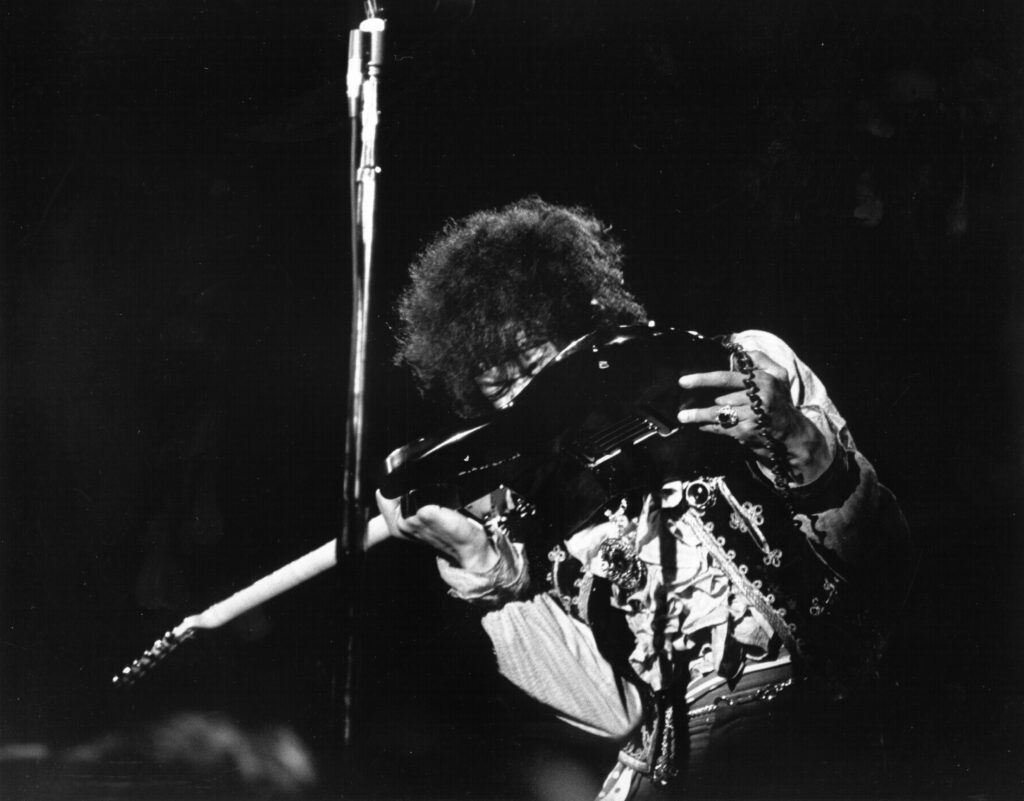
Photo by Michael Ochs Archives/Getty Images
Hendrix continued to solo in the same manner later in the set. To hear playback of the performance, which was professionally recorded, is to be struck by how he sustained the tremendous tone and fluency of his playing with his mouth on the strings.
Shortly afterward, Hendrix lifted the instrument behind his head as shown in the still beneath.
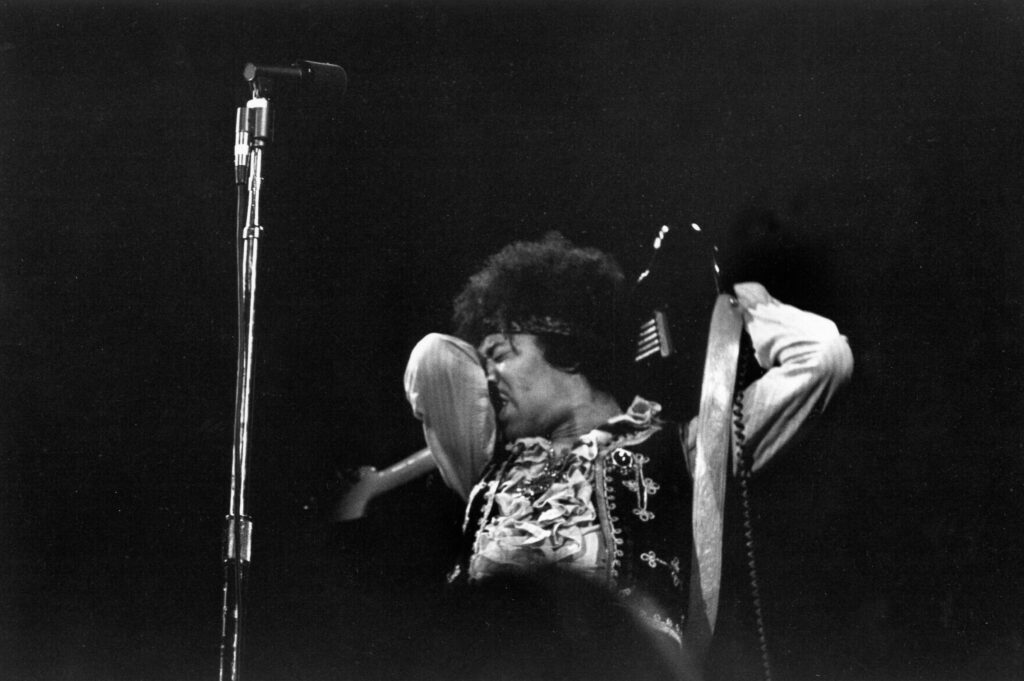
Photo by Michael Ochs Archives/Getty Images
Holding it this way, he went into another dazzling solo. Later still he demonstrated he could keep the rhythm and sing a chorus with the guitar behind his back.
At one point, he carried a tune with only one hand on the strings—while rolling over on the floor—all while he appeared to be jawing on chewing gum. In reaction shots of the crowd, captured in acclaimed documentarian D.A. Pennebaker’s film of the festival, the faces are gobsmacked.
The Monterey set built to what Hendrix introduced as “the English and American anthem combined” after first oddly indicating that a “sacrifice” was soon to be made. Then he momentarily made a series of drawn-out droning sounds with his guitar before beginning to play “Wild Thing,” which had been a chart-topping hit for The Troggs a year earlier.
He concluded the act with a long instrumental finale, during which he provocatively thrust and ground his instrument into an amplifier.
The performance ended with Hendrix laying his guitar down on the stage, dousing the thing in lighter fluid, and then setting it alight as he knelt there. He was photographed from multiple angles as he affected to conjure the flames higher. The pictures taken, including the one below, became the definitive images of Hendrix at Monterey Pop and stand among the most iconic of all rock history.
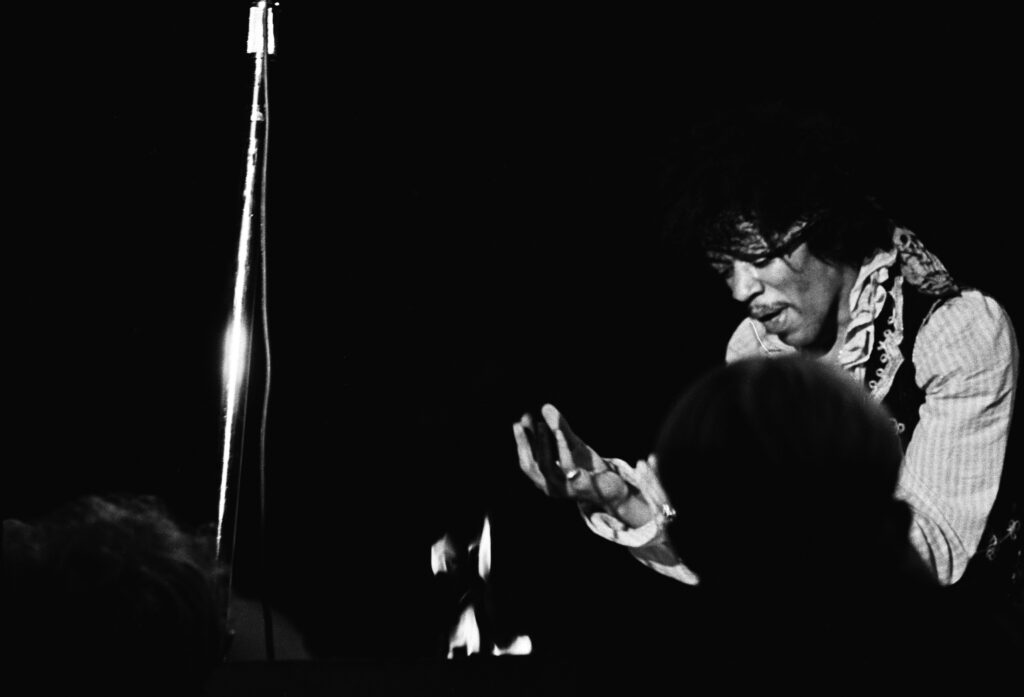
Photo by Michael Ochs Archives/Getty Images
Those flames roared briefly before Hendrix stood, took the guitar by the neck, and smashed it to pieces–one of which has been displayed at the Met. It continued to generate an odd droning sound for a long moment, as Hendrix abruptly exited the stage under thunderous applause.
The appearance propelled Hendrix to prominence in the United States. Frank Sinatra’s Reprise Records, with whom he soon signed a U.S. distribution deal, produced this poster promoting the Hendrix Experience in association with the guitarist’s audacious acts at Monterey Pop. It had been a spectacular showcase of chaotic behavior that demonstrated total mastery over his instrument in the dawning age of the guitar hero.
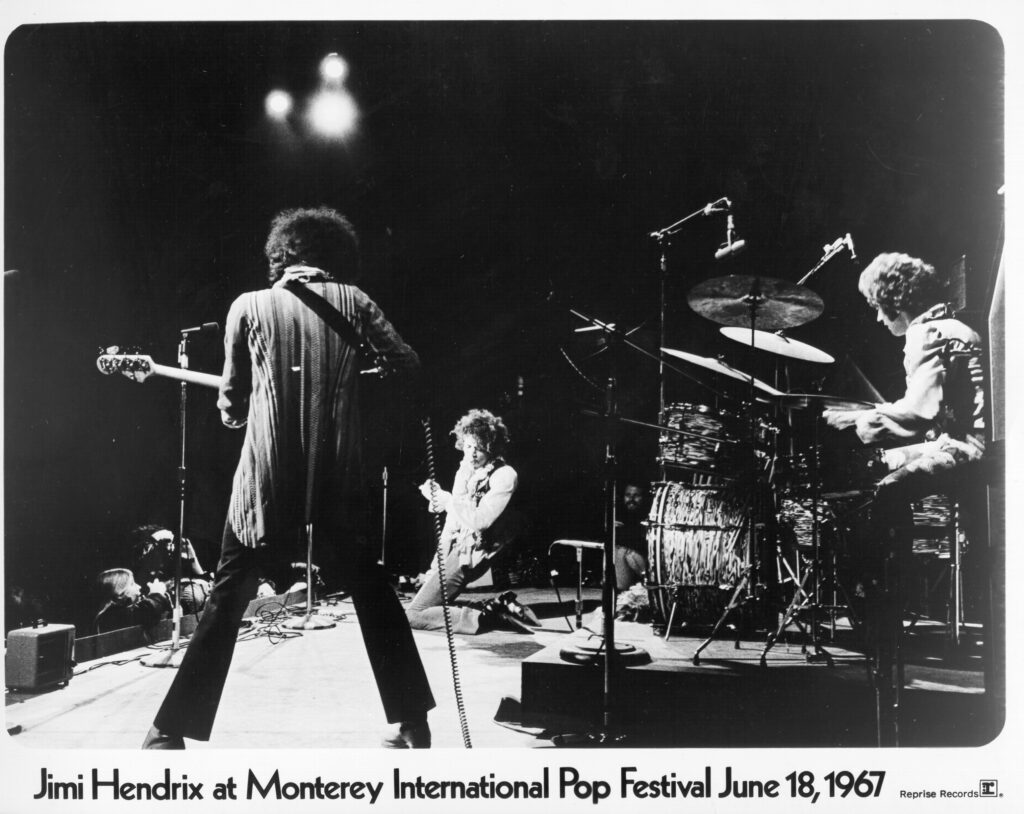
That performance turned out to be a sort of overture to the rest of Jimi’s life. It was the American blues tradition, the hip folk revival, the motifs of psychedelia, strands of mysticism, and innovative methods of electronic audio generation, blended into one shocking sound that Hendrix described as “beautiful rock-blues-country-funky-freaky.”
It was a marvelous fusion he sustained for a precious little time. Just three years and three months after Hendrix destroyed his guitar at Monterey, he inadvertently destroyed himself by way of an overdose of sedatives at the age of 27. An entirety of just four proper albums released in his lifetime, besides several more important concert sets, were sufficient to guarantee his legacy.

Learn More:
Cross, Charles R. Room Full of Mirrors: A Biography of Jimi Hendrix (2006).
Carafe, Ed. Burning Desire: The Jimi Hendrix Experience Through the Lens of Ed Caraeff (2018).
Alan Douglas and Peter Neal, eds. Starting at Zero: His Own Story (2014).
Steven Roby, ed. Hendrix on Hendrix: Interviews and Encounters with Jimi Hendrix (2012).
Green, Martin I., and Bill Sienkiewicz. Voodoo Child: The Illustrated Legend of Jimi Hendrix (1995).
D. A. Pennebaker, dir. Jimi Plays Monterey (1987).
Joe Boyd, John Head and Gary Weis, dirs. A Film About Jimi Hendrix (1973).
D. A. Pennebaker, dir. Monterey Pop (1968).
Bob Smeaton, dir. Jimi Hendrix: Hear My Train A Comin’ (2013).
David Barnhizer and Bob Smeaton, dirs. Jimi Hendrix: The Dick Cavett Show (2002).
The Jimi Hendrix Experience, Are You Experienced (1967).
The Jimi Hendrix Experience, Live at Monterey (2007).
The Jimi Hendrix Experience, Axis: Bold as Love (1967).
The Jimi Hendrix Experience, Electric Ladyland (1968). Jimi Hendrix, Band of Gypsys (1970).


